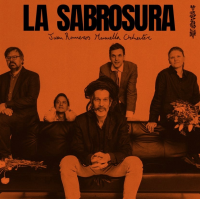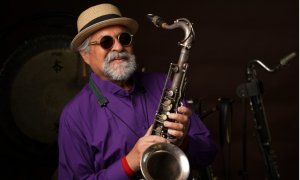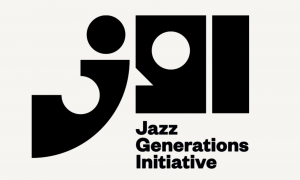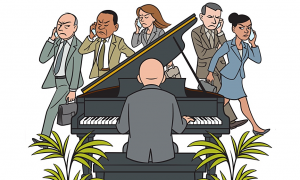104 East 126th Street
New York, NY 10035
212 348-8300
The National Jazz Museum in Harlem announces its exciting September 2007 schedule of jazz events, from its weekly adult education classes, Jazz for Curious Listeners, to a new Jazz in the Parks concert series, its bi-weekly interview series Harlem Speaks, to the continuation of the Harlem in the Himalayas performances at the Rubin Museum of Art.
Either in performance or in discussion, you'll find something for your tastes below, from leading generational lights Christian McBride leading classes on Fusion JAZZ and Kenny Washington doing a two-part tribute to his mentor Max Roach, to performances by those who embrace free jazz, to masters of the idiom, such as Junior Mance, and a compositional giant, Johnny Mandel. Firebrand Fred Ho performs as does the distinctive Howard Johnson, and a fine young talent, Dayna Stephens.
With the exception of Harlem in the Himalayas, every event below is free!
Tuesday, September 4, 2007
JAZZ for CURIOUS LISTENERS with Christian McBride
Fusion, Pt. 1
7:00 pm | At the Harlem School of the Arts
The National Jazz Museum in Harlem proudly continues its free adult jazz course, JAZZ FOR CURIOUS LISTENERS, with jazz museum co-director Christian McBride discussing the Fusion style, which combined elements from jazz, funk, rock and pop into a mlange that some jazz artists and critics argue was not jazz. Some even called the music CONfusion! McBride will tackle these controversies while playing and discussing the music of Weather Report, Miles Davis, Return to Forever and others noted for pioneering this genre. He'll also confront the issue of fusion's worth in light of this critique: it don't mean a thing if it ain't got that swing. Fusion largely excised swing from its palette of musical options. Is this a bad thing? Come hear Christian McBride on September 4, 2007 to find out! Classes are Tuesdays, 7 p.m. -- 8:30 p.m.
The location is the Harlem School of the Arts, 645 St. Nicholas Avenue (just south of 145th Street).
To register: http://www.jazzmuseuminharlem.org/curious.html
Transportation:
Buses - M3, M18
Subways - A, C, D, B, to 145th Street
Thursday, September 6, 2007
HARLEM SPEAKS
Junior Mance, Pianist
6:30 pm | at the Harlem School of the Arts, 645 St. Nicholas Avenue (off 141st Street)
call 212-348-8300 to RSVP
FREE
JUNIOR MANCE, born Julian Clifford Mance, Jr. on October 10, 1928, is a jazz pianist, composer, author of “HOW TO PLAY BLUES PIANO", and recording artist of thirty plus albums as a leader and numerous recordings as a sideman. He began playing the piano at the age of five, and began formal training at the age of eight.
In 1947 Mance left Roosevelt College to join Gene Ammons' band and began his recording career with Ammons. He joined Lester Young in 1949 for almost two years, and rejoined Ammons several months in 1951 before being drafted into the U. S. Army. He served in the 36th Army Band at Fort Knox, Kentucky along with Julian “Cannonball" Adderley. After his discharge from the Army in 1953, Mance became part of the house rhythm section at the Bee Hive Jazz Club in Chicago for a year, and accompanied jazz greats such as Charlie Parker, Coleman Hawkins, Eddie “Lockjaw" Davis, Sonny Stitt, and many others. In 1954 Mance joined and toured with Dinah Washington. In 1956 he reunited with Cannonball Adderley, becoming a member of Cannonball's first organized working band. The band did a series of recordings on Mercury Records.
Junior joined Dizzy Gillespie's band in 1958, a period Mance considers one of the highlights of his career. Besides the joy and fun of playing with Dizzy, he remembers this period as a great learning experience in musicianship, showmanship, and just about everything related to the business of music. In 1961 Junior decided to form his own trio, following the release of his first recording as a leader. (Junior, Verve Records ) In between gigs with his trio he played and recorded with the Eddie “Lockjaw" Davis/Johnny Griffin Quintet. With his trio he also accompanied singer Joe Williams in l963/64.
In 1988 Junior became a member of the faculty of the JAZZ AND CONTEMPORARY MUSIC PROGRAM at the New School University in New York City. He teaches classes in Blues, Blues Ensembles, and private individual lessons and instruction on piano and helping students in the development of their career in playing jazz.
On November 21, 1997, at Tampa Florida, Junior was inducted into THE INTERNATIONAL JAZZ HALL OF FAME, an honor Junior is extremely proud of, being in the elite company of many of his heroes, both past and present.
Junior Mance made his solo piano debut at Lincoln Center at the Kaplan Penthouse on October 5th - 7th of 2000. If you haven't attended Harlem Speaks, yet know the power, majesty, grits and grace of jazz, or want to learn more about this profound musical art form, don't miss this jazz legend's discussion with museum executive director Loren Schoenberg.
Friday, September 7, 2007
HARLEM IN THE HIMALAYAS
Duology: Michael Marcus and Ted Daniel
7:00 pm | at the Rubin Museum of Art
Considering their strong backgrounds, detailed below, this duo should enchant and move all in attendance at the acoustically-rich hall at the Rubin Museum in Art.
Michael Marcus, a performer on various reed instruments, possesses a full, rich tone and a logical yet open-ended style of phrasing that reflects his background in both bop and free jazz. From 1977 to 1980, Marcus toured with blues artists Bobby “Blue" Bland and Albert King. Marcus made his recording debut in 1982 on Sonny Simmons and Billy Higgins' Backwoods Suite. Marcus continued to play and study jazz in New York for the next decade, but his work from this period is largely undocumented.
1992, however, saw the release of Under the Wire, featuring William Parker, Joseph Bowie, Ted Daniel and Reggie Nicholson, among others. Marcus continued to record in earnest throughout the 1990s, performing on a string of albums under his own name. The first of those was 1994's Here At!, which marked the only time that Fred Hopkins had recorded with either Denis Charles or William Parker. 1995 saw the release of a self-titled album by Saxemble, in which Marcus played with Frank Lowe, James Carter and others. In 1996, CIMP released two albums by Simmons that featured Marcus. In 1997, Marcus toured with pianist Jaki Byard, and their collaboration, Involution, was released in 1998. In 1998 and 1999, Marcus' other projects included writing string arrangements for his compositions. Since 2000, Marcus has continued to perform and record frequently.
Ted Daniel began studying trumpet in elementary school. He began his professional career playing local gigs with his childhood friend, the legendary guitarist, Sonny Sharrock. Mr. Daniel briefly attended Berklee School of music and Southern Illinois University before a tour of duty will U.S. Army Bands. After his discharge from the Army, Mr. Daniel attended Central State College, in Ohio, on a full music scholarship where he met and studied with Dr. Ken Makanda McIntyre. After a year, Mr. Daniel returned to NYC and eventually received a bachelor of music degree in theory and composition from the City College of New York. Mr. Daniel had begun his recording career while in Ohio returning to New York to record Sonny Sharrock's first album, Black Woman.
His second recording, Brute Force, on the Embryo label, produced by Herbie Mann, was with a band he co-led (Brute Force) with his brother, Richard Daniel. Since then, Mr. Daniel has participated in over thirty published recordings with such great artist such as: Archie Shepp, Dewey Redman, Andrew Cyrille, Sam Rivers, Billy Bang and Henry Threadgil. Mr. Daniel has produced three albums under his own name. Mr. Daniel has been the recipient of a NEA compositional grant and awarded Talent Deserving Wider recognition from Downbeat Magazine. Presently, Mr. Daniel is writing and performing with his new group, the International Brass and Membrane Corporation (IBMC). This trio was conceived as a flexible and expandable creative music performance group which utilizes instruments from the brass and membrane instrument families.
The Rubin Museum of Art is located at 150 West 17th Street New York, NY.
The fee is $20 and the program will last until 8:30pm.
Transportation:
Subways -#1 to 18th Street
Tuesday, September 11, 2007
JAZZ for CURIOUS LISTENERS with Kenny Washington
Remembering Max Roach Pt. 1
7:00 pm | At the Harlem School of the Arts
Like Christian McBride, drummer and historian and collector of jazz Kenny Washington is one of the best jazz musicians of his generation. Few are better qualified to discuss the legacy of the late Max Roach, one of the finest and most innovative percussionists of the 20th century. This will be Part I of a consecutive, two-part exploration of musical genius.
Washington has played and recorded with a virtual who's who of an older generation (Lee Konitz, Betty Carter, Benny Carter, Johnny Griffin, Phil Woods, to name a few) as well as his own: Bill Charlap, Peter Washington, Kenny Kirkland, and dozens of others. Known from his days on WBGO as the “Jazz Maniac," Kenny Washington is one of the most articulate and spirited exponents of the art of jazz. Not only will he discuss Roach's legacy and play recordings from his vast collection; Washington will demonstrate on drums what made Max Roach such an innovator and master musician.
Classes are Tuesdays, 7 p.m. -- 8:30 p.m.
The location is the Harlem School of the Arts, 645 St. Nicholas Avenue (just south of 145th Street)
To register: http://www.jazzmuseuminharlem.org/curious.html
Transportation:
Buses - M3, M18
Subways - A, C, D, B, to 145th Street
Wednesday, September 12, 2007
JAZZ IN THE PARKS
7:00 pm | Marcus Garvey Park (Pelham Fritz Recreation Center)
Jazz in Harlem: A Magical Legacy with the Jazz Museum in Harlem All-Stars
Led by the National Jazz Museum in Harlem executive director, Loren Schoenberg, this free concert, the first of a series sponsored by the City of New York Department of Parks, will feature music associated with Harlem in a swingin' jazz style. While the weather's still warm, bathe in the sonorous sounds of a cool yet fiery group of multi- generation lights of today's jazz idiom.
Friday, September 14, 2007
HARLEM IN THE HIMALAYAS
The Grachan Moncur Quartet
7:00 pm | at the Rubin Museum of Art
Grachan Moncur III (born June 3, 1937) is one of the few real free jazz trombonists, as well as a prolific composer. He is the son of jazz bassist Grachan Moncur II and the nephew of jazz saxophonist Al Cooper.
Born and raised in Newark, New Jersey, Grachan began playing the cello at age nine, and switched to the trombone at eleven. In high school he attended the Laurinburg Institute in North Carolina, the private school where Dizzy Gillespie had studied. While still in school he began sitting in with touring jazz musicians on their way through town, such as Art Blakey and Jackie McLean, with whom he formed a lasting friendship.
After high school he toured with Ray Charles (1959-1962), Art Farmer's and Benny Golson's Jazztet (1962), and Sonny Rollins. He took part in two classic Jackie McLean albums in the early 1960s to which he also contributed the bulk of compositions and which led to two influential albums of his own for Blue Note Records, Evolution (1963) with Jackie McLean and Lee Morgan, and Some Other Stuff (1964) with Herbie Hancock and Wayne Shorter.
After leaving Blue Note, Grachan joined Archie Shepp's ensemble and recorded with other avant-garde players such as Marion Brown, Beaver Harris and Roswell Rudd (the other big name in free jazz trombone). During a stay in Paris in the summer of 1969, he recorded two albums as a leader for the famous BYG Actuel label, New Africa and Aco Dei de Madrugada, as well as appearing as a sideman on numerous other releases of the label. In 1974, the Jazz Composers' Orchestra of America commissioned him to write “Echoes of Prayer" (1974), a jazz symphony featuring a full orchestra plus vocalists and jazz soloists.
His sixth album as a leader, Shadows (1977) was released only in Japan. Unfortunately, he was subsequently plagued by health problems and copyright disputes and recorded only rarely. Through the 1980s he recorded with Cassandra Wilson (1985), played occasionally with the Paris Reunion Band and Frank Lowe, appeared on John Patton's Soul Connection (1983), but mostly concentrated on teaching. In 2004 he re-emerged with a new album, Exploration, on Capri Records featuring Grachan's compositions arranged by Mark Masters for an octet including Tim Hagans and Gary Bartz.
The Rubin Museum of Art is located at 150 West 17th Street New York, NY
The fee is $20 and the program will last until 8:30pm.
Transportation:
Subways -#1 to 18th Street
Tuesday, September 18, 2007
JAZZ for CURIOUS LISTENERS with Kenny Washington
Remembering Max Roach Pt. 2
7:00 pm | At the Harlem School of the Arts
Come hear and see jazz drum virtuoso Kenny Washington as he discusses bebop pioneer Max Roach's legacy--Part II. It isn't possible to encompass Roach's greatness as a musician and thinker on jazz in just a week, so Washington will come back to further enrich the understanding of listeners interested in the jazz idiom's pantheon of leading innovators. Roach will go down in history as a man who made the traps drums talk with sensitivity and taste, creative brilliance and commitment. He extended, elaborated and refined the drum innovations of Shadow Wilson, Papa Jo Jones, and Kenny Clarke into a style that fit Charlie Parker, Dizzy Gillespie, Clifford Brown, Sonny Rollins and hundreds of other fellow jazz masters like a leather glove. Washington will break all this down in sound, playing music, explicating verbally and demonstrating on drums what Roach means to the culture and history of jazz. Classes are Tuesdays, 7 p.m. -- 8:30 p.m.
The location is the Harlem School of the Arts, 645 St. Nicholas Avenue (just south of 145th Street).
To register: http://www.jazzmuseuminharlem.org/curious.html
Transportation:
Buses - M3, M18
Subways - A, C, D, B, to 145th Street
Thursday, September 20, 2007
HARLEM SPEAKS
Johnny Mandel, composer/arranger
6:30 pm | at the Jazz Museum offices
call 212-348-8300 to RSVP
FREE
Considered one of the top living composers, Johnny Mandel is one of the few writers around capable of writing standards that can be recorded and performed by a wide variety of jazz musicians and singers. He began writing arrangements when he was 13 but he made his living during the 1940's as a trombonist and trumpeter, generally playing in sections of big bands. He picked up experience playing trumpet with Joe Venuti (1943) and Billie Rogers, switching to trombone for stints with Boyd Raeburn, Jimmy Dorsey, Buddy Rich, Georgie Auld, Alvino Rey and most notably Woody Herman's Second Herd (1948) where his “Not Really The Blues" was one of several pieces that entered the book. He also worked with Chubby Jackson, Elliot Lawrence and Count Basie (1953), but by the early 1950's Mandel's writing skills were in greater demand than his trombone playing. He contributed arrangements for Artie Shaw's short-lived bop band (1949) and for Basie (1952-56). Settling in Los Angeles in 1953, Mandel (who played bass trumpet for a brief time with Zoot Sims before ending his active playing) since then has made a living writing for films including occasional scores that are jazz-oriented, most notably 1958's I Want To Live and 1965's The Sandpiper (which resulted in “The Shadow Of Your Smile"). In addition to his movie work, Mandel has written arrangements for a countless number of performers including Frank Sinatra and Shirley Horn. Other famous Mandel songs include “Emily" (from The Americanization Of Emily), “Close Enough For Love," “Hershey Bar" (recorded by Stan Getz), “Suicide Is Painless" (the “Theme from Mash") and “A Time For Love."
Friday, September 21, 2007
HARLEM IN THE HIMALAYAS
Fred Ho
7:00 pm | at the Rubin Museum of Art
Fred Ho, born Fred Wei-han Houn in Palo Alto, California, August 10, 1957) is an American jazz baritone saxophonist, composer, bandleader, playwright, writer, and social activist.
While he is sometimes associated with the Asian American jazz or avant-garde jazz movements, Ho himself is opposed to the use of term “jazz" to describe traditional African American music because the word “jazz" was used pejoratively by white Americans to denigrate the music of African Americans. Also an activist, many of his works fuse the melodies of indigenous and traditional Asian and African musics, which as Ho would say is the music of the majority of the world's people. He has also written two books: Legacy to Liberation: Politics and Culture of Revolutionary Asian Pacific America and Sounding Off! Music as Subversion/ Resistance/ Revolution. He has a third book in progress about African Americans and Asians working together in civil rights, which he is co-writing with Purdue University professor of African American studies, Bill Mullen. Ho's contributions to the Asian American empowerment movement are varied and many. He is credited with co-founding several Asian American civic groups such as the East Coast Asian Students Union while a student at Harvard, The Asian American Arts Alliance in New York City, The Asian American Resource Center in Boston, and the Asian Improv record label.
Of Chinese descent, Ho specializes in the combining sometimes asynchronous tunes and melodies of various musical traditions, creating what many have described as both brilliant and chaotic sounds. He is the first to combine Chinese opera with traditional African American music. He leads the Afro Asian Music Ensemble (founded in 1982) and the Monkey Orchestra (founded in 1980). He lives in the Greenpoint section of Brooklyn, New York.
Ho holds a B.A. degree in sociology from Harvard University (1979). He has recorded for the Koch Jazz and Soul Note labels. Some of his most recent works include Deadly She-Wolf Assassin at Armageddon, which premiered in Philadelphia, Pennsylvania in June 2006, Voice of the Dragon I, II, and III. As Ho is a prolific composer, writer, playwright, his list of works grows continually.
The Rubin Museum of Art is located at 150 West 17th Street
New York, NY. The fee is $20 and the program will last until 8:30pm.
Transportation:
Subways -#1 to 18th Street
Tuesday, September 25, 2007
JAZZ for CURIOUS LISTENERS with Christian McBride
Fusion, Pt. 2
7:00 pm | At the Harlem School of the Arts
The National Jazz Museum in Harlem's free adult jazz course, JAZZ FOR CURIOUS LISTENERS, continues its two-part focus on the Fusion style, with the National Jazz Museum in Harlem's co-director Christian McBride.
McBride, one of the best acoustic bass players of any generation is noted for being a master of straight-ahead jazz who also enjoys playing the electric bass. Of course, he's a master of that instrument also. His Christian McBride Band plays a plethora of styles, including funk and fusion. McBride is a strong, eloquent rejoinder to the jazz police, whether critics or other famous jazz musicians who dislike venturing off the reservation of straight ahead jazz. No one questions McBride's chops or his soulful intelligence, so come hear one of the world's greatest musicians discuss why fusion ain't necessarily CONfusion! Classes are Tuesdays, 7 p.m. -- 8:30 p.m.
The location is the Harlem School of the Arts, 645 St. Nicholas Avenue (off 141st Street)
To register: http://www.jazzmuseuminharlem.org/curious.html
Transportation:
Buses - M3, M18
Subways - A, C, D, B, to 145th Street
Wednesday, September 26, 2007
JAZZ IN THE PARKS
7:00 pm | Marcus Garvey Park (Pelham Fritz Recreation Center)
An Evening with Howard Johnson: A Life in Music
A guest of the Harlem Speaks series in early 2006, Howard Johnson will now do what he does best: play a variety of instruments (tuba, baritone sax, among others) with sympathetic band mates with soul and vigor. Don't miss this free performance!
Born August 7, 1941, in Montgomery, Alabama, Johnson moved to Massillon, Ohio in 1944 with his family. He taught himself baritone saxophone in 1954, and learned tuba a year later. Johnson plays other reeds and trumpet as well. He recently became a resident of Harlem, but first moved to New York in 1963, where he worked with Charles Mingus (1964-1966 and 1972-1974), Hank Crawford (1965-1967), Archie Shepp (1966-1968), and Buddy Rich (1966).
He started a 20-year association with Gil Evans in 1966. In the late- '60s and early part of the'70s he worked in Los Angeles with Quincy Jones, Gerald Wilson and Oliver Nelson. From 1975-1980 he worked in the Saturday Night Live band, serving as bandleader for the last two years.
In the late '70s, he formed a tuba band called Gravity that has recorded two CDs on the Verve label. Johnson has also recorded with Jack DeJohnette's Special Edition, Jimmy Heath, Bob Moses, George Gruntz's Concert Jazz Band, and frequently with Evans' orchestra, among others.
During the '90s, in addition to work with Gravity and J.J. Johnson (The Brass Orchestra in 1996), he played in Spike Lee's film soundtracks for School Daze, Mo' Better Blues Malcolm X, and Clockers.
Friday, September 28, 2007
HARLEM IN THE HIMALAYAS
Coltrane 6:00/7:00 pm | at the Rubin Museum of Art
6:00
Book Launch: Ben Ratliff, New York Times jazz writer, discusses his new biography of John Coltrane. Free.
7:00
A concert celebrating the birthday of the legendary jazz master John Coltrane and marking the New York City concert debut of saxophonist Dayna Stephens, accompanied by a stellar rhythm section. Dayna Stephens was born in Brooklyn, New York august 1st, 1978, and was raised in the San Francisco bay area. He began playing the saxophone at age 13. He attended the prestigious Berkeley High School and took part in their jazz ensemble. Dayna was then accepted to Berklee College of Music in Boston, MA on a full scholarship. There, he studied with Hal Crook, Billy Pierce, George Garzone and Andy McGee among others. While in Boston, Dayna also had the opportunity to perform with Chick Corea and the Boston Pops for a P.B.S. special. After graduating from Berklee, Dayna was selected to be in the Thelonious Monk Institute of jazz program located at the University of Southern California (USC) in Los Angeles by Herbie Hancock, Wayne Shorter and Terence Blanchard. He studied there for 2 years and while there, Dayna studied and played with, among others: Dave Holland, Kenny Barron, Wayne Shorter, Herbie Hancock, John Scofield, Lewis Nash, Mark Turner, Christian McBride, Carl Allen and Terence Blanchard who was the artistic director of the program. In the spring of 2003 the Monk group made a recording featuring Terence Blanchard, Herbie Hancock, and Wayne Shorter. The recording featured some of the best compositions and arrangements made by group throughout their 2 years spent together.
For more information contact Jim Eigo, Jazz Promo Services.



























